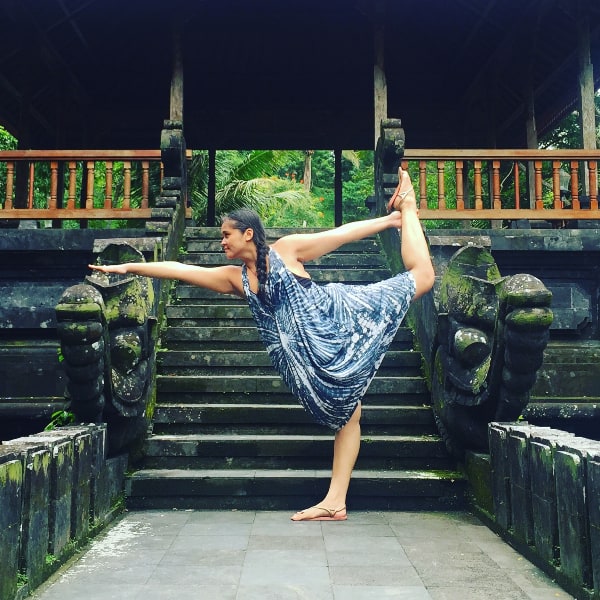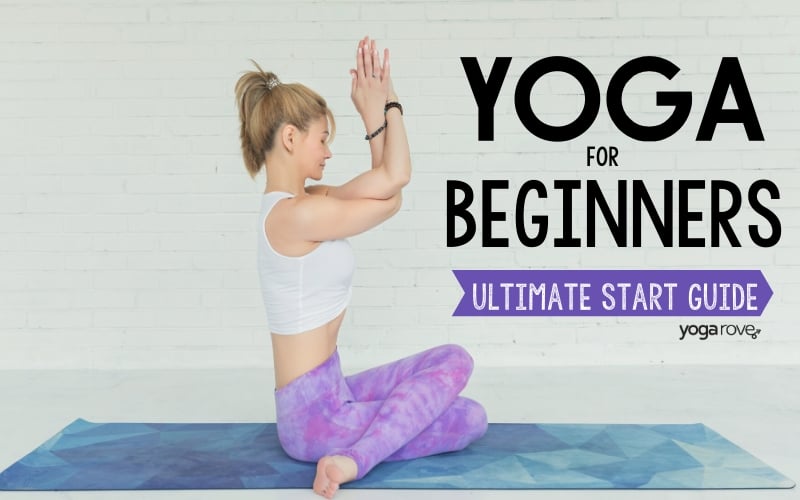This post may contain affiliate links. Please read our disclosure for more info.
Many yoga poses call for open hamstrings and hips and an elongated spine. Paschimottanasana, or Seated Forward Fold, is a great pose to open up your body and increase flexibility and range of motion.
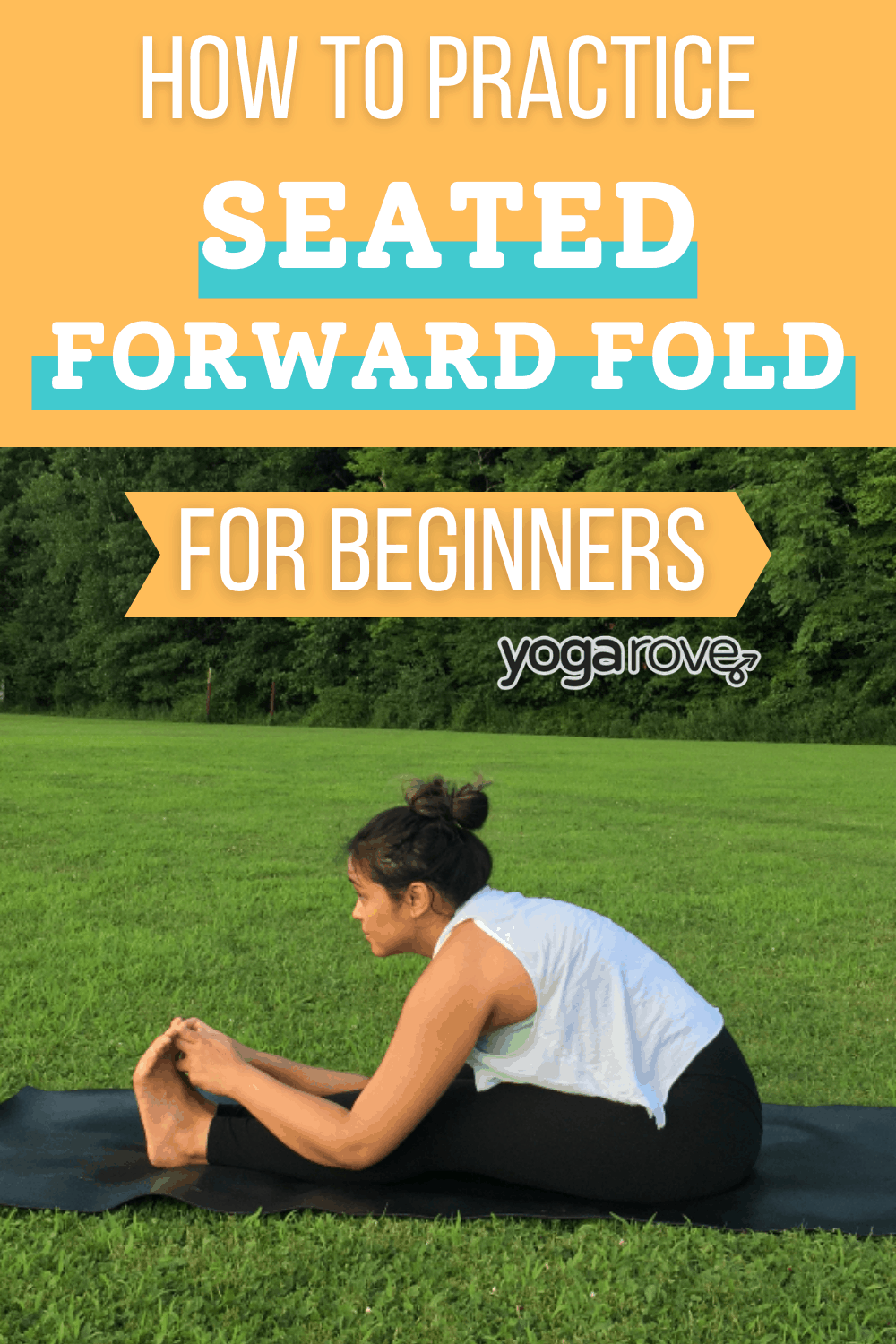
Often practiced toward the end of yoga practice, this seated posture has many different variations and modifications depending on your body and what you are looking to open and stretch. Many yogis use props like straps or blocks to assist or deepen the posture.
Benefits of Seated Forward Fold
Seated Forward Fold holds tons of benefits for the body. And they aren’t just physical either! Here are some benefits of the posture:
- Lengthens the spine
- Strengthens your upper body
- Opens the hamstrings and hips
- Tones and strengthens your legs
- Strengthens your ankles and toes
- Stimulates your digestive organs
- Alleviates menstrual cramps
- Opens and stretches your body your head to your toes
Warming Up for Seated Forward Fold
There are many variations to Seated Forward Fold, but traditionally, it is practiced with a long spine and straight legs. In order to find this in your body, it is a good idea to practice postures that open up your hamstrings and hips and poses where you can practice lengthening your spine.

Childs Pose
This pose creates a nice stretch to open up your hips and back body.
- Sit on your knees at the center of your mat.
- Open your knees apart as wide as your mat and bring your big toes to touch behind you.
- Begin to walk your hands forward and take your forehead on the mat.
- Rest your head, hands, and elbows on the mat.
- Relax your shoulders away from your ears as you sink your hips down toward your heels.
- Stay for 5 deep breaths.
Standing Forward Bend
This pose is essentially Seated Forward Fold but in a standing position.
- Stand at the top of your mat with your feet apart hips-width distance.
- Fold forward at your hips and grab onto your big toes with your middle and index fingers. Create a nice, tight grip and bend your knees as much as you need to.
- Inhale to lengthen your spine and look forward. As you exhale, fold forward and take your stomach toward your thighs.
- Bend your elbows to the side of the room and use your arm strength to pull your belly closer to your thighs.
- Keep your legs strong and engaged by rolling your weight forward to the balls of your feet and engaging your thigh muscles.
- Keep lengthening your spine and stay for 5 breaths.
Wide-Legged Forward Bend
This posture is also a forward fold and a nice warm-up to your Seated Forward Bend.
- Standing at the back of your mat, turn to face the left side.
- Take a big step out with your right foot and take your arms out parallel to the mat. Check that your feet are under your wrists and your toes are pointing forward.
- Inhale to lengthen the spine and as you exhale, fold forward at your hips keeping your spine long.
- Bend your knees if you need to and reach for your big toes with your middle and index fingers. Bend your elbows out to the sides and pull on your big toes as you reach the crown of your head toward the mat.
- Try to straighten your legs as much as you can, engage your thigh muscles, and lengthen your spine.
- Stay for 5 deep breaths.
Bound Angle Pose
A seated posture, Bound Angle pose opens your hips. Try this right before your Seated Forward Fold.
- Sit on your mat with the soles of your feet touching and your knees pointing out to the sides of your mat. Your legs should look like a diamond shape.
- Place your hands gently on your feet and lengthen your spine.
- Start to slowly fold forward, keeping your spine long. Think of taking your chest to your feet and feel an opening in your hips and your spine.
- Stay for 5 breaths.
How to Practice Seated Forward Fold
Before practicing your Seated Forward Fold, make sure to practice a few preparatory poses first. This pose is active, so check that your legs are activated with your toes flexed.
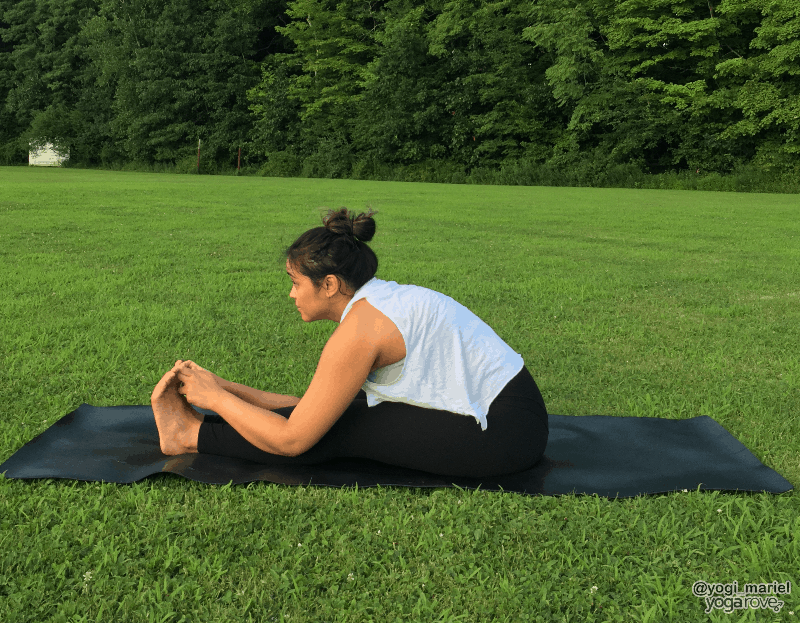
To practice Seated Forward Fold:
- Start seated at the back of your mat.
- Extend your legs straight out in front of you and take your big toes and thighs to touch,.
- Engage your legs and your thigh muscles by flexing your feet and firing up your muscles.
- Inhale to lift your arms up overhead. Lengthen your spine and lift your upper body out of your waist.
- As you exhale, draw your belly in and fold forward at your hips.
- With your middle and index fingers, grab onto your big toes and create a tight grip. Bend your knees if you need to.
- Keep your spine long and gaze toward your toes.
- Inhale again to find length in the spine.
- As you exhale, begin to take your stomach toward your thighs.
- Bend your elbows and use the strength of your arms to pull your body forward.
- If you can, straighten your legs completely.
- Relax your shoulders away from your ears.
- Keep flexing your feet, pulling on your big toes, engaging your legs, and lengthening your spine.
- Gaze toward your big toes and stay for 5 breaths.
Common Misalignments
Feeling a little misaligned in your Seated Forward Fold? Here are some common misalignments:
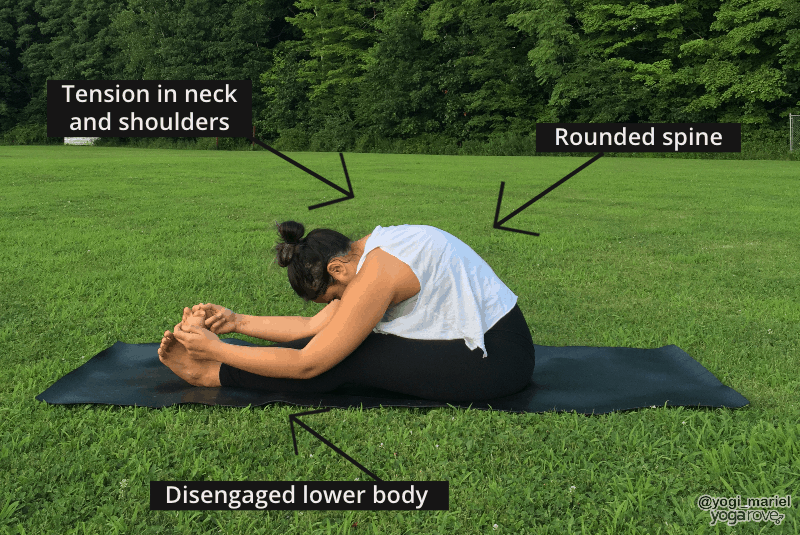
- Rounded spine: While there are variations of Seated Forward Fold that are more restorative, traditionally, the pose is practiced with a lengthened spine. If you notice that your spine is rounding, bend your knees more or use a blanket under your hips for more support. Find a long spine by bending the knees and focus on keeping the chest lifted instead of collapsing forward.
- Disengaged lower body: Make sure that your legs are working in this pose. Flex your feet so that your toes are pointing straight up to the ceiling. You should feel your thighs and calves engaged as well as if your muscles are hugging the bone. If you have the strength and flexibility, you can even lift your heels off of the mat in your Seated Forward Fold.
- Tension in the neck and shoulders: Because you are using your arm strength to pull your upper body down to your lower body, this can cause tension in the neck and the shoulders. Check-in and make sure that your shoulders are relaxed away from your ears and that your neck is relaxed and free. Your gaze can be at your big toes, or slightly forward from your big toes.
Modifications
Modify your Seated Forward Fold with some of these modifications:

- Bend your knees: If it is challenging to reach for your toes with straight legs, bend your knees as much as you need to so that you can find your grip. Focus on keeping your spine long, instead of keeping your legs straight.
- Use a blanket or block: If it is uncomfortable in your hips or uncomfortable to straighten your legs, you can use a blanket or a block under your hips for more support. In addition, you can also roll up a blanket to place underneath your knees for extra support.
- Use a strap: Instead of grabbing onto your big toes with your peace fingers, use a strap, Wrap the strap around the arches of your feet and gently pull on the strap. Make sure to focus on a long spine and keep your legs engaged with toes flexed.
Tips for Beginners
- Engage your core: Although this is a seated posture, it is important to keep your core engaged to support your lower back. Think of drawing your belly button in toward your spine and keep your abs in tight.
- Move slowly: Move with your breath in this pose and take your time coming in and out of the posture. Avoid jerky or sudden movements and allow yourself to find depth slowly. Use your inhales to find length and space, and use your exhales to soften into the shape while keeping your body engaged.
- Keep your chest open: To aid in lengthening your spine, keep your collar broad and heart open. Think of lifting your chest to find space in the front of your body. Keep your gaze forward instead of down to find space and openness in the chest.
Variations in Seated Forward Fold
There are many variations that you can practice in your Seated Forward Fold. Here are a few fun ones that you can try:

- Reach for your feet: Instead of grabbing your big toes, reach for the sides of your feet or interlace your fingers around the arches of your feet. If you are very flexible, you can place a block in front of your feet and reach for the block instead.
- Find a restorative version: Release your entire body in your Seated Forward Fold by relaxing the arms alongside your legs, relaxing your feet and your toes, and releasing your upper body down toward your lower body. Let your head and neck relaxing and allow gravity to do the work.
- Use a partner: Practice this pose with a partner by touching the soles of your feet together. Face each other and fold forward at the hips. Instead of reaching for your big toes, reach for each other’s hands and take turns gently pulling your arms forward.
Contraindications
If you are pregnant, take a restorative version of Seated Forward Fold and use a pillow to rest your upper body on. Have issues with your hamstrings? Bend your knees or use props. If you have a slipped disc or back injury, avoid or modify this posture as it can place stress and pressure on your lower back.
Seated Forward Fold can feel amazing towards the end of your yoga practice. It stretches and lengthens not only your legs but your spine as well. Try some of its variations or modifications next time you practice!


